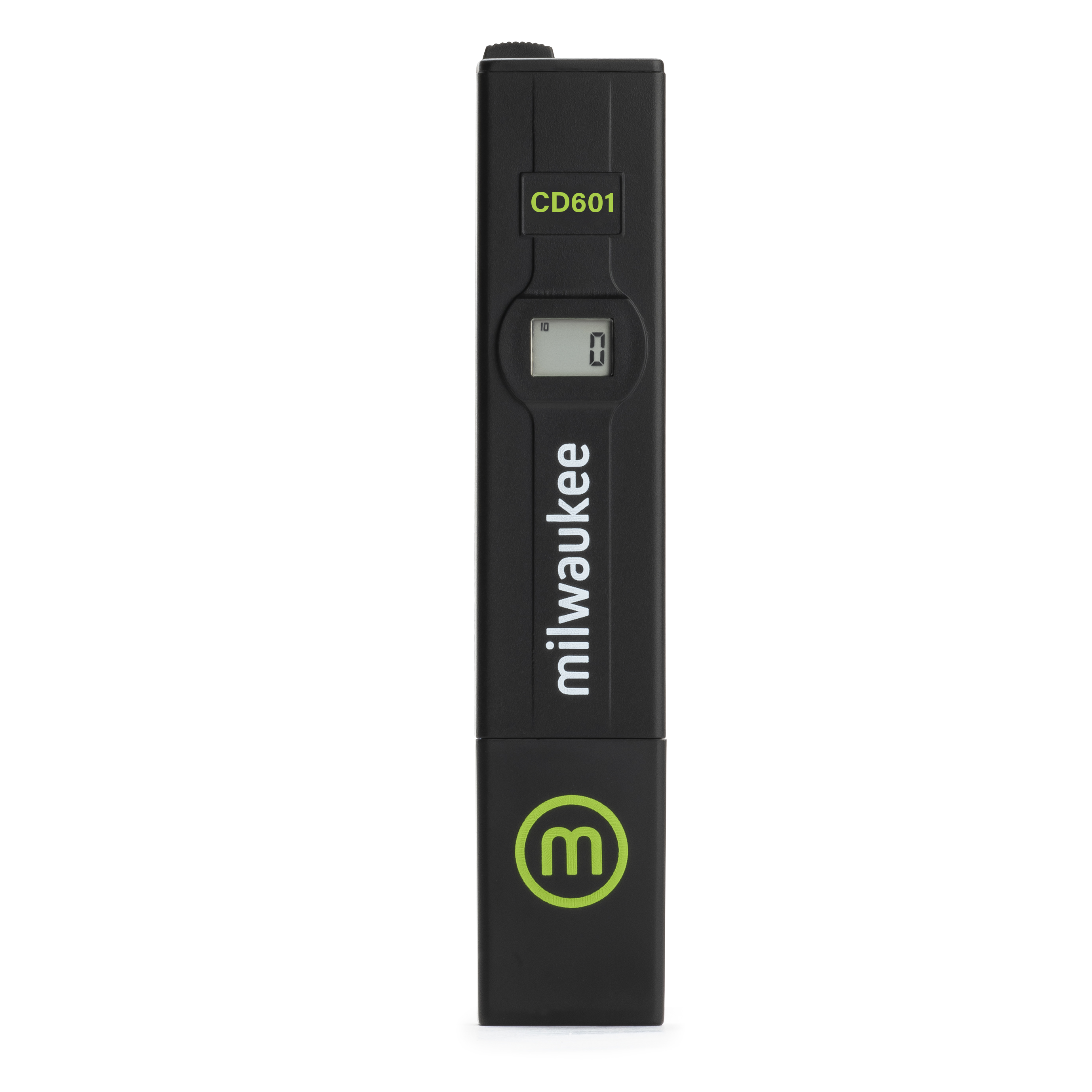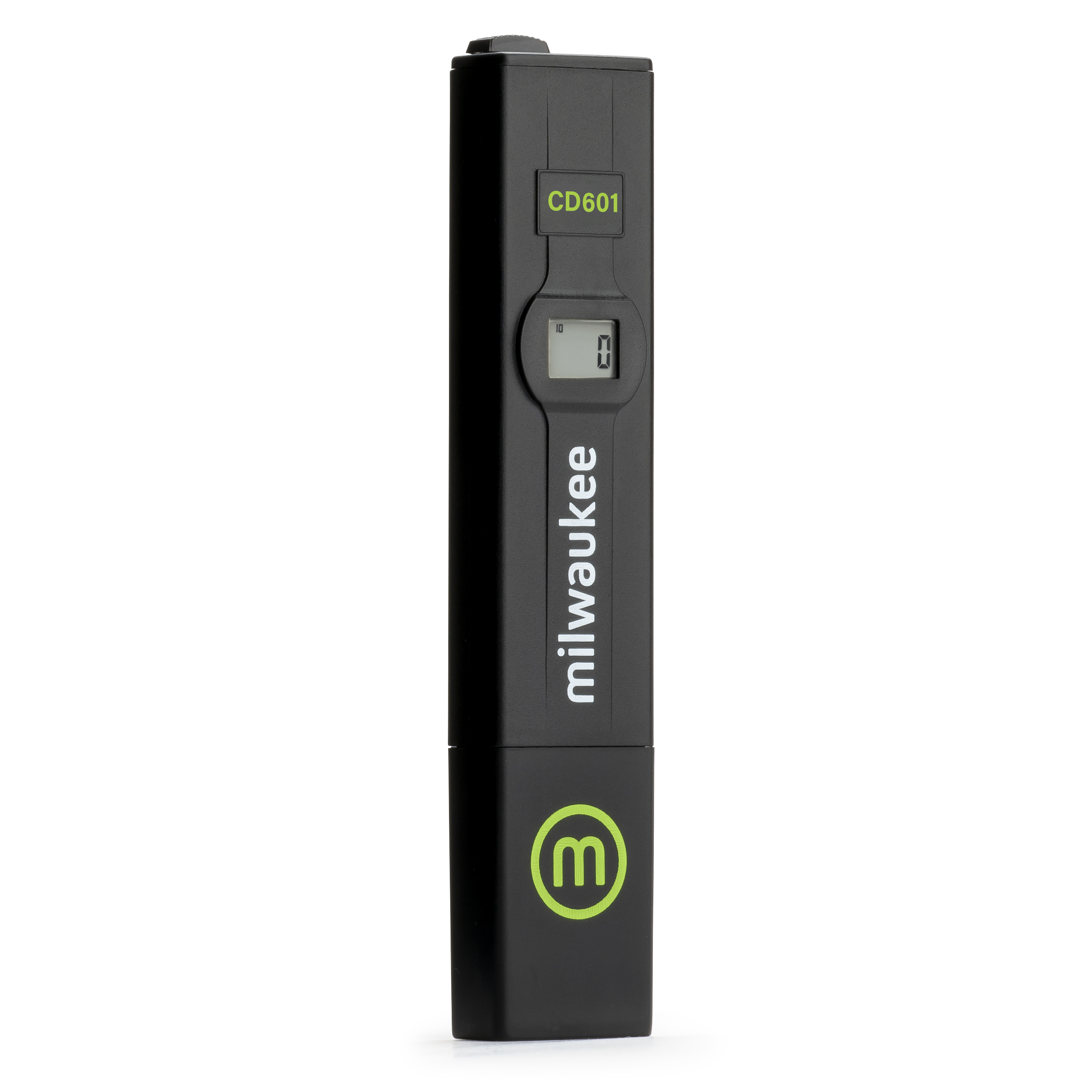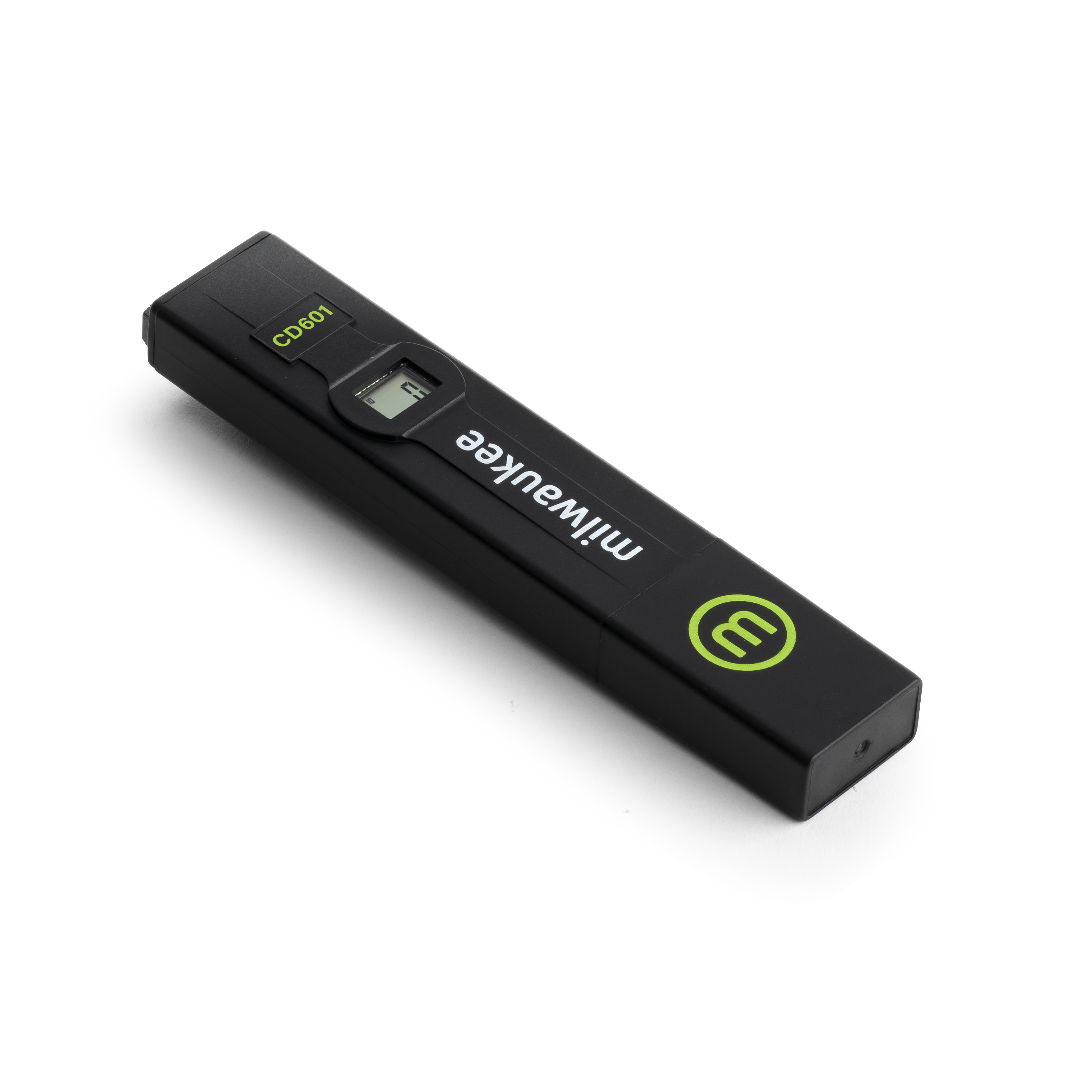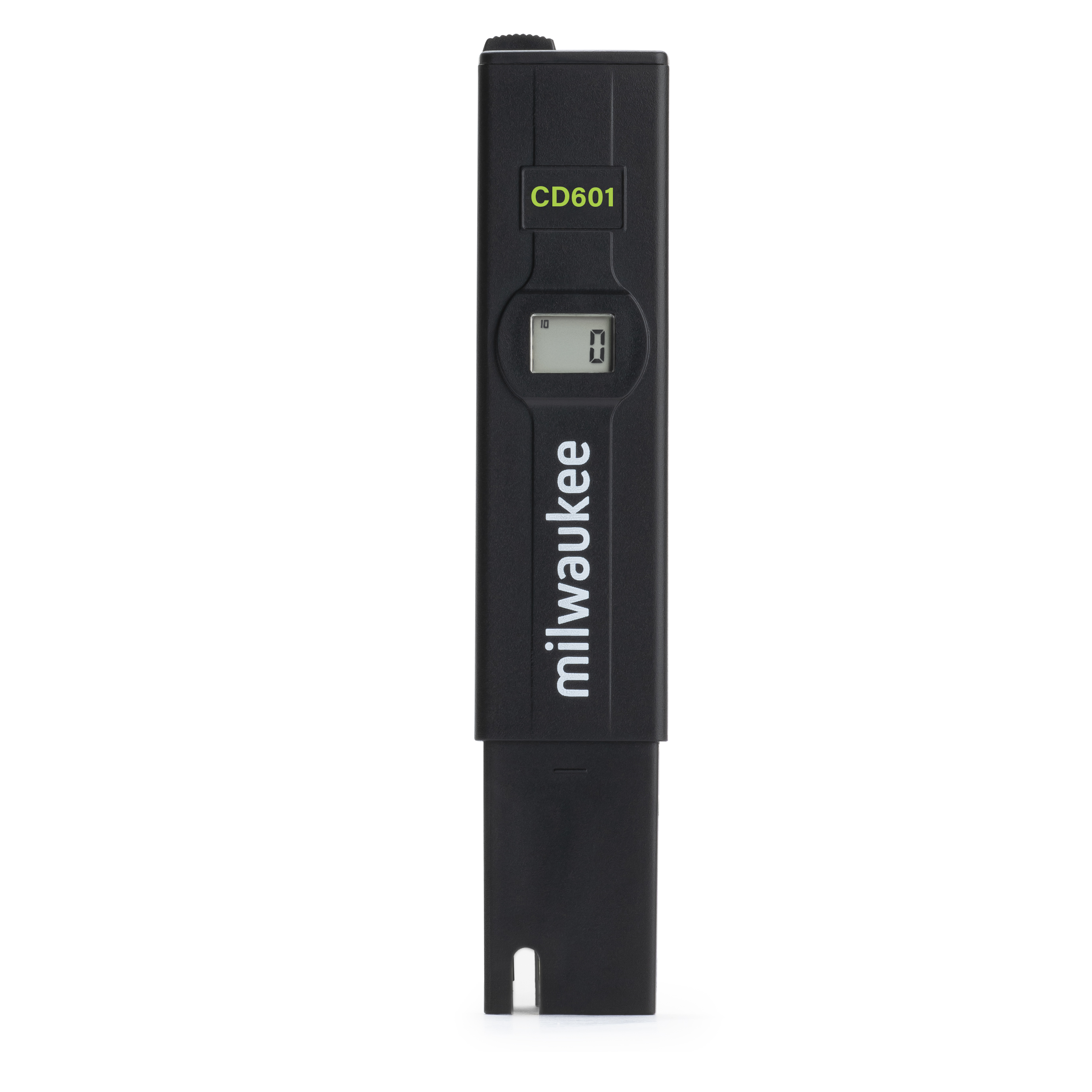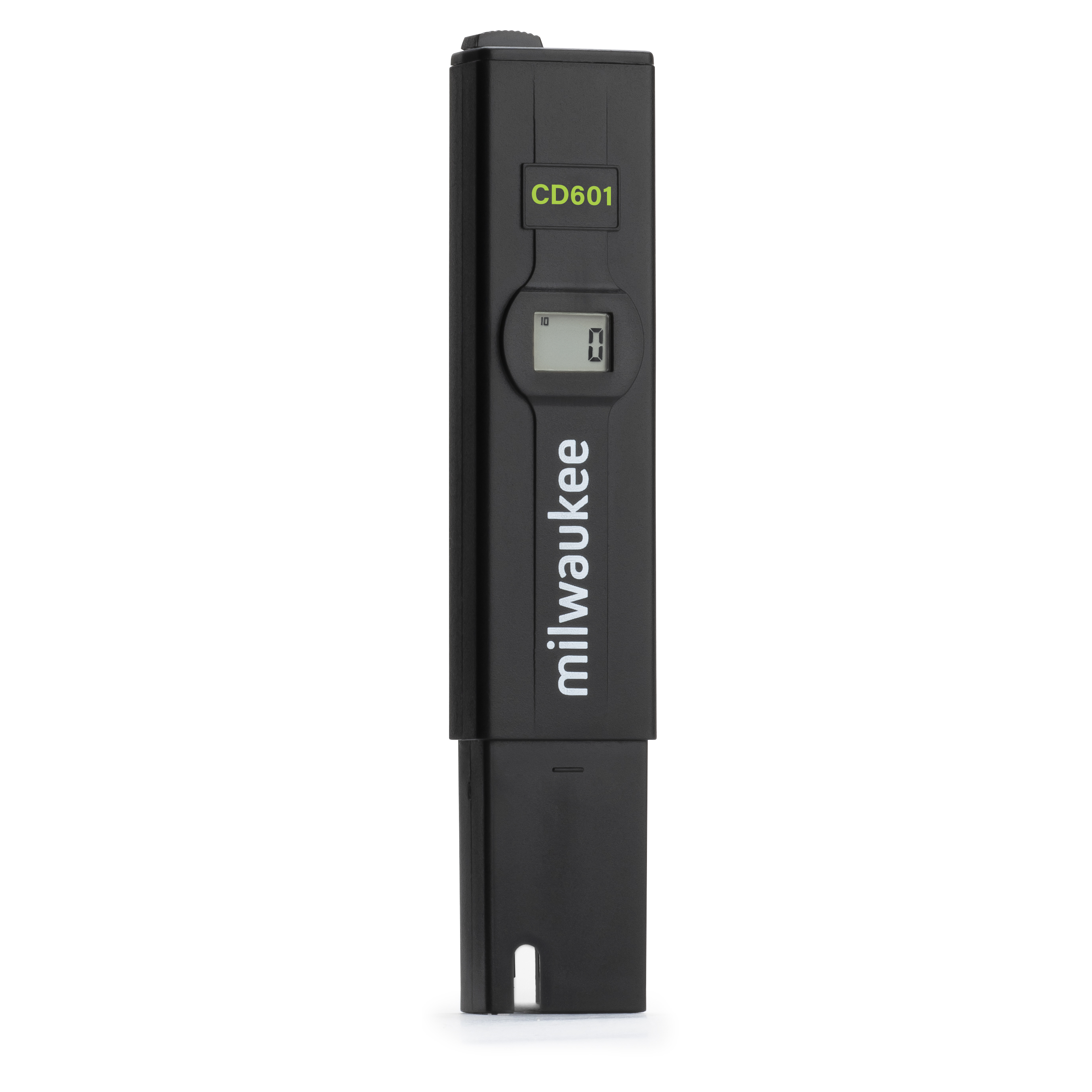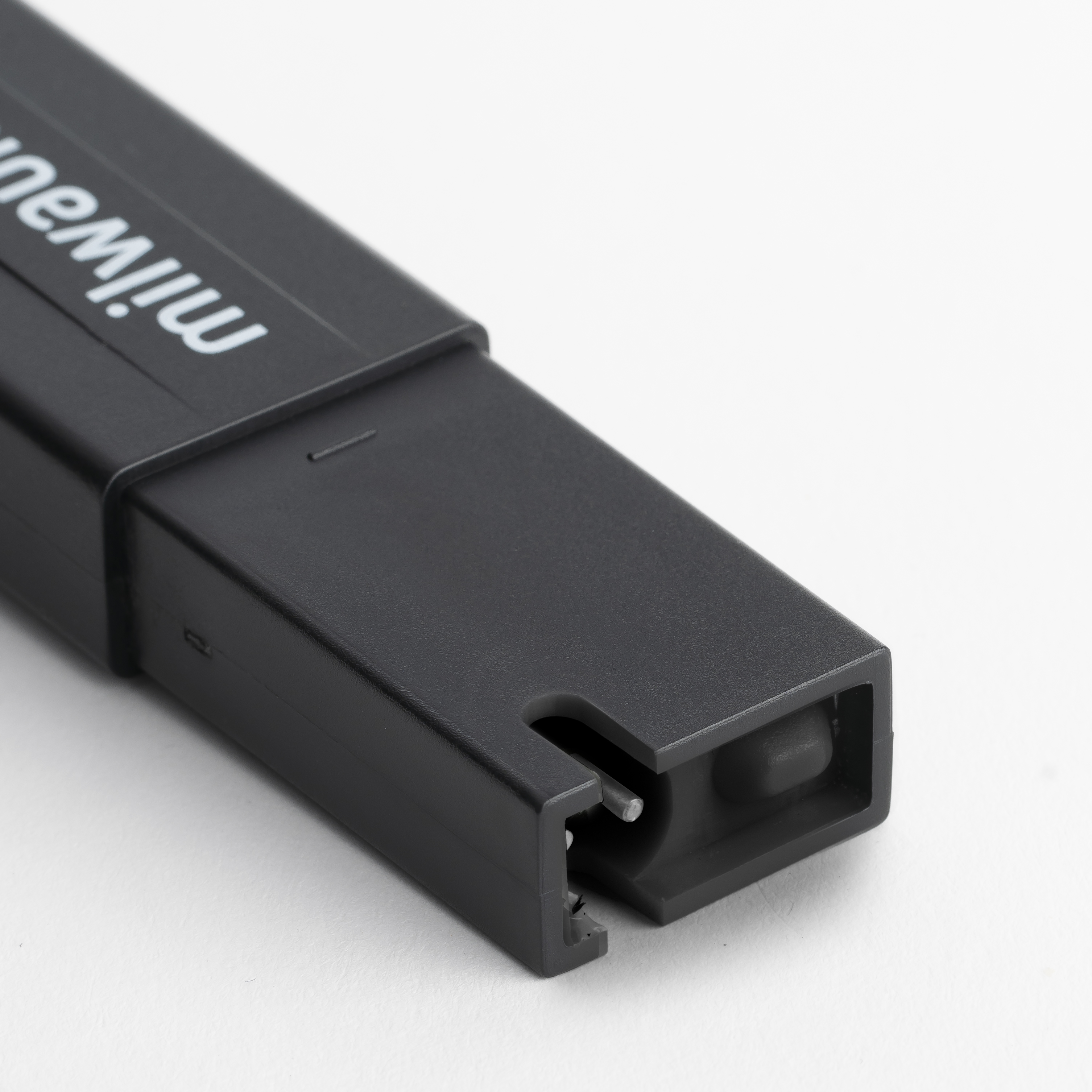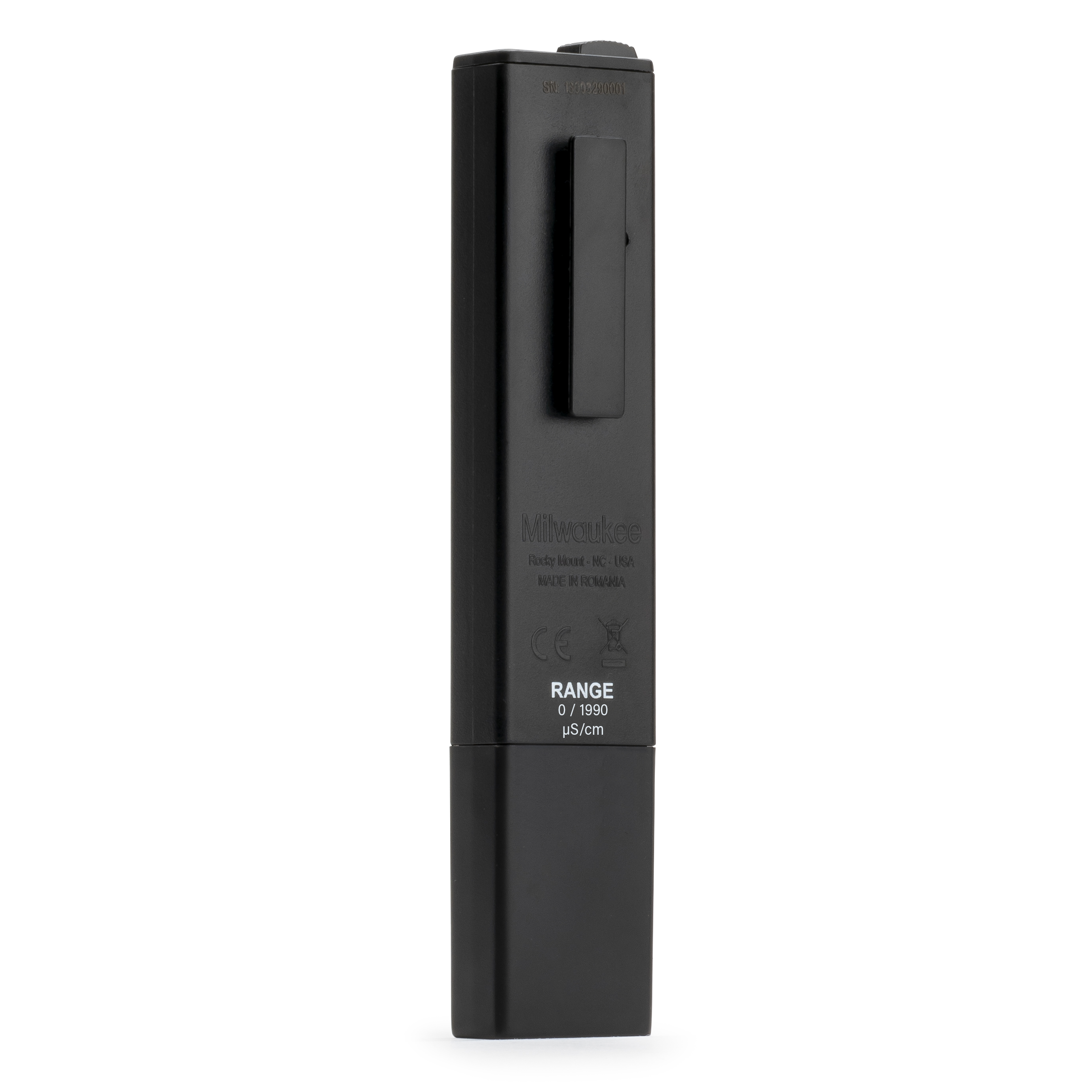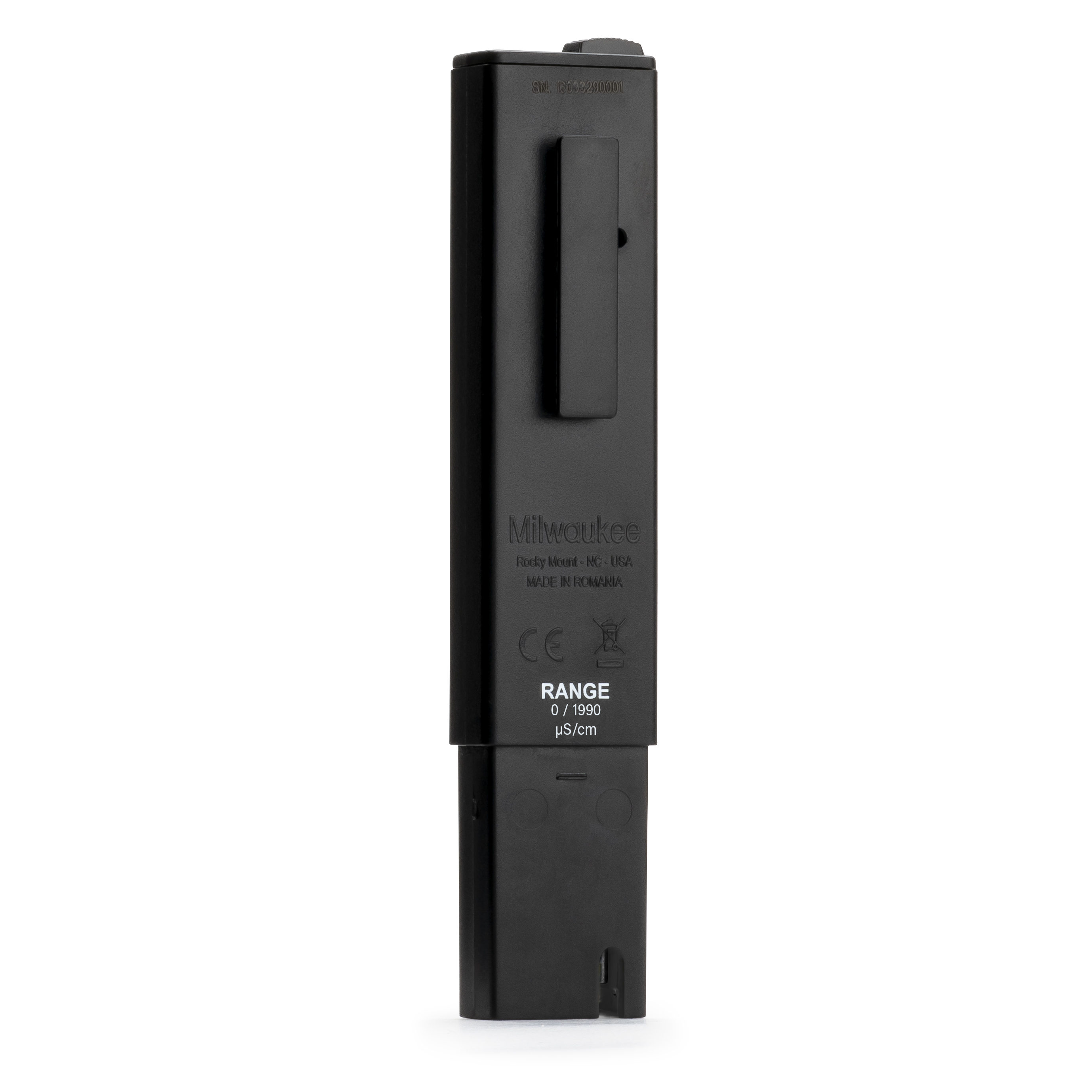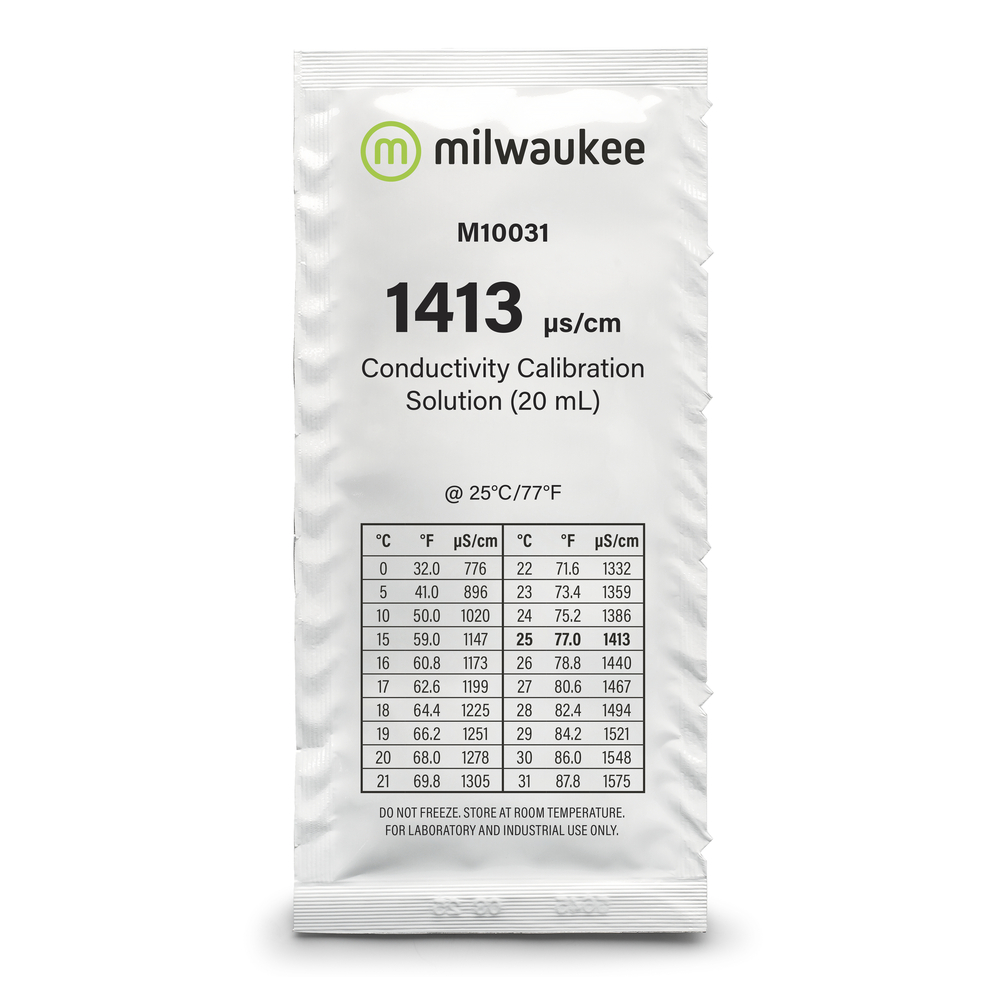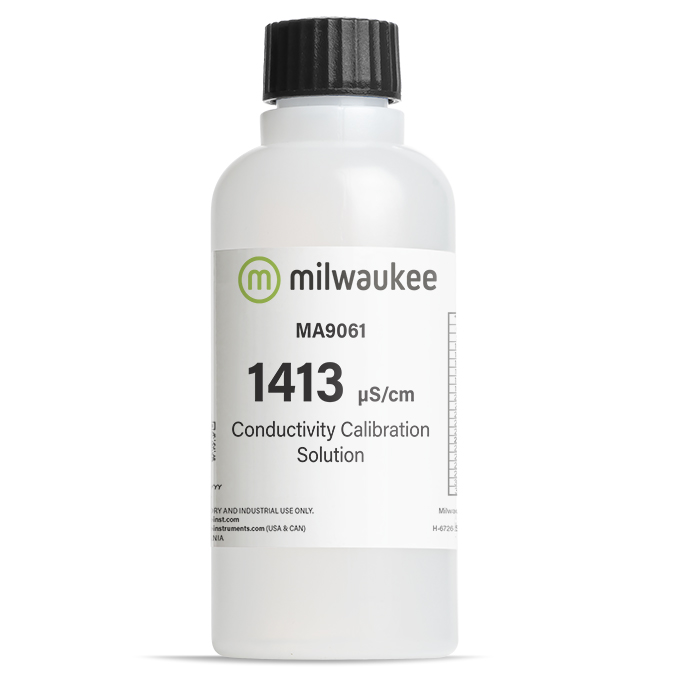Your shopping cart is currently empty.
Milwaukee CD601 Digital Conductivity Pen – Simple, Accurate EC Testing in the Palm of Your Hand
In today’s fast-paced world of precision agriculture, water quality management, and controlled environment farming, knowing your water’s conductivity is more essential than ever. Whether you're feeding delicate hydroponic crops, balancing salinity in an aquarium, or ensuring water purity for research or industrial processes, the Milwaukee CD601 gives you reliable EC measurements without the bulk of lab equipment.
This compact digital EC pen is designed for people who need quick, accurate readings without fuss. With a sleek and ergonomic design, intuitive operation, and a fast-response probe, the CD601 allows professionals and hobbyists alike to measure the electrical conductivity of their solution in seconds. No complicated setup. No guessing. Just clear results you can trust.
It’s the tool of choice for growers checking nutrient concentration, technicians validating system performance, and field testers on the move. Lightweight yet durable, the CD601 brings lab-grade precision to your fingertips – whether you’re in a greenhouse, lab, factory, or out in the field.
Why Choose the Milwaukee CD601 EC Pen?
- Quick, Accurate Readings: Delivers EC measurements with ±2% full scale accuracy for fast and confident decision-making.
- One-Point Manual Calibration: Easy and reliable calibration to ensure ongoing accuracy with minimal effort.
- Durable and Portable: Compact design fits in your pocket and resists everyday wear and tear, making it ideal for field or on-site use.
- Easy-to-Read Display: Clear LCD screen shows EC values instantly, even in bright light or challenging environments.
- Energy Efficient: Auto shut-off extends battery life – perfect for mobile testing or remote work.
- Replaceable Electrode: Swappable probe extends the life of your meter and minimizes long-term cost of ownership.
Whether you're testing nutrient solutions or checking water quality in a pond, the CD601 helps you act quickly and confidently – without bulky meters or lab trips.
Applications
The Milwaukee CD601 is trusted across a wide range of industries and disciplines:
Hydroponics & Controlled Agriculture
Monitor EC in nutrient solutions to ensure plants are absorbing the right balance of nutrients. Avoid over-fertilization and nutrient lockout to boost growth and crop quality.
Aquariums & Aquaculture
Maintain proper salinity and water conditions to support the health of fish and marine life. A quick EC check helps detect water quality shifts before they become critical.
Laboratory & Research
Ideal for researchers who need portable, fast EC testing in the lab or field. Useful in environmental sampling, chemistry, or biological sciences.
Drinking Water & Filtration Systems
Check dissolved solids to evaluate water purity or filter
performance – —whether
you're testing tap water, well systems, or RO filters.
Industrial Water Management
Used in manufacturing and water treatment settings to monitor conductivity in cooling towers, boilers, and process water loops to prevent corrosion or scaling.
Environmental Monitoring
Test lakes, rivers, or runoff for salinity and ionic changes – helping scientists detect pollution or ecological shifts in the field.
Proper Care & Maintenance
To ensure long-lasting accuracy and performance of your CD601 Conductivity Pen, regular maintenance is key. Here's how to keep your meter in top shape:
Electrode Care
- Always rinse the EC probe with distilled water after use to avoid residue buildup.
- Do not scratch or touch the sensing surface – handle the probe gently.
Storage
- Always store the meter dry with the protective cap in place.
- Avoid exposure to extreme temperatures or prolonged direct sunlight.
Cleaning
- If the probe becomes fouled with nutrient or mineral deposits, soak it in Milwaukee Cleaning Solution (MI708) to restore sensitivity.
- Avoid using tap water or chemicals not intended for EC probe cleaning.
Calibration
- Regular calibration using a standard EC solution (e.g., 1413 µS/cm) ensures continued accuracy.
- Perform calibration before critical measurements or after periods of storage.
By following these care tips, you’ll extend the lifespan of your CD601 and ensure precise results every time.
Compact. Reliable. Essential.
Whether you're testing at the grow site, in the lab, or out in the wild, the Milwaukee CD601 delivers professional-level EC measurements with speed and simplicity. Upgrade your water testing routine today with the trusted performance of Milwaukee Instruments.
Specifications
Application
Hydroponics & Agriculture
In hydroponics and soil-less farming systems, where plants grow without traditional soil to buffer nutrients, precise control of nutrient concentration in water is absolutely critical. Electrical Conductivity (EC) is a direct measure of the total dissolved salts – or nutrients – present in your solution. The Milwaukee CD601 EC Pen enables growers to track this with ease.
If EC levels are too low, your plants may suffer from nutrient deficiencies, resulting in slow growth, pale leaves, and reduced yields. On the other hand, if EC is too high, it can lead to nutrient burn, root damage, or salt buildup, which harms plant health and limits nutrient uptake. This condition is known as nutrient lockout – a common problem in intensive growing setups.
By monitoring EC daily with the CD601, growers can:
- Adjust fertilizer levels precisely based on plant stage (seedling, vegetative, flowering).
- Identify overfeeding or underfeeding before symptoms appear.
- Fine-tune water and nutrient delivery systems to achieve optimal growth conditions.
- Reduce waste by avoiding overuse of fertilizers, saving money and protecting the environment.
This tool is especially helpful in:
- NFT (Nutrient Film Technique)
- DWC (Deep Water Culture)
- Coco coir or rockwool drip irrigation systems
- Commercial greenhouses and vertical farms
With fast, accurate EC readings, the CD601 becomes a daily decision-making tool, giving you insight into your root zone environment and preventing costly mistakes.
How to Use the CD601 in Hydroponics & Agriculture
Using the Milwaukee CD601 EC Pen is simple and effective. Here’s a step-by-step guide for hydroponic growers:
1. Prepare Your Sample
- Stir your nutrient reservoir or irrigation water to ensure it is evenly mixed.
- Scoop a small amount of solution into a clean container, or dip the probe directly into the reservoir.
2. Turn on the Meter
- Press the power button on the CD601.
- Wait for the display to activate.
3. Dip the Probe
- Immerse the probe tip into the nutrient solution to the indicated immersion line.
- Ensure no air bubbles are trapped around the probe sensor.
- Stir gently for a few seconds.
4. Read the EC Value
- Wait for the display to stabilize.
- Note the EC value (in µS/cm or mS/cm) displayed on the screen.
- Compare the reading to the ideal EC range for your crop and growth stage (e.g., lettuce: 0.8–1.2 mS/cm, tomatoes: 2.0–3.5 mS/cm).
5. Rinse and Store
- Rinse the probe with distilled water to remove nutrient residues.
- Gently shake off excess water and replace the protective cap.
- Store the meter in a clean, dry location.
6. Calibrate Weekly
- Use a standard calibration solution (e.g., 1413 µS/cm) to maintain accuracy, especially before mixing new batches of nutrients.
Aquariums & Aquaculture
In aquatic systems, water quality is life support. Whether you're maintaining a vibrant home reef aquarium, running a commercial fish hatchery, or cultivating shrimp in aquaculture ponds, the health and survival of your aquatic life depends on stable and appropriate salinity and mineral balance.
Electrical Conductivity (EC) is a key parameter for understanding the total dissolved solids in your water – primarily salts and minerals. While EC isn’t a direct salinity reading, it correlates closely with salinity levels, making it a trusted indicator for aquarists and fish farmers alike.
Using the Milwaukee CD601 EC Pen helps you:
- Monitor salinity levels consistently, which is especially critical in brackish or marine tanks and aquaculture operations.
- Prevent sudden salinity shifts, which can cause osmotic stress, disease, or even mass die-offs in sensitive species.
- Track buildup of waste and ions in closed systems where evaporation can concentrate salts.
- Evaluate water changes or new source water before introducing it to your tank or pond.
Whether you're breeding ornamental fish, raising tilapia or trout, or simply maintaining a coral reef display, EC monitoring ensures you're not relying on visual cues alone—many water issues are invisible until it's too late.
The CD601 gives fast feedback, allowing you to act before small changes become dangerous problems.
How to Use the CD601 in Aquariums & Aquaculture
Here’s a step-by-step guide to help aquarists and aquaculture technicians use the Milwaukee CD601 effectively:
1. Collect the Water Sample (Optional)
- For aquariums or small systems: You can dip the probe directly into the tank.
- For larger ponds or tanks, use a clean container to collect water from mid-depth.
2. Power On the Device
- Press the power button to activate the CD601.
- Ensure the LCD display is working and no error messages are shown.
3. Submerge the Probe
- Dip the probe tip into the water, up to the immersion line.
- Avoid touching substrate or fish – take the reading in open water.
- Gently stir the probe to eliminate any trapped bubbles.
4. Read the EC Value
- Wait a few seconds for the value to stabilize.
- Record the EC measurement displayed in µS/cm or mS/cm.
- Compare the reading to the ideal EC/salinity range for your aquatic species:
- Freshwater tanks: 100–500 µS/cm
- Brackish systems: 1,000–10,000 µS/cm
- Marine tanks: 30,000–50,000 µS/cm (usually measured in salinity ppt; EC gives a close proxy)
5. Interpret and Adjust
- If EC is rising: it may indicate evaporation (and increasing salt concentration), poor water change frequency, or overfeeding.
- If EC is dropping: possible dilution from freshwater top-offs or incomplete mineralization in source water.
- Adjust accordingly through water changes, salt additions, or system maintenance.
6. Rinse & Store
- Rinse the probe tip with distilled water after each use.
- Shake off excess water and place the protective cap back on.
- Store the meter in a clean, dry environment.
7. Calibrate Periodically
- Regular calibration with EC standard solution (e.g., 1413 µS/cm or 12.88 mS/cm) ensures your readings remain trustworthy – especially in critical operations like hatcheries or sensitive reef systems.
Laboratory & Research
In scientific research, precision and repeatability are everything. Whether you're conducting experiments in a laboratory or collecting field samples for environmental analysis, accurate EC measurements are often essential for understanding the composition of aqueous solutions.
The Milwaukee CD601 is an ideal companion for chemists, biologists, environmental scientists, and field technicians who need:
- A portable, quick, and reliable tool to assess the ionic content of solutions
- A cost-effective alternative to bulky bench-top conductivity meters
- A rugged, simple meter for on-site measurements in remote or outdoor settings
Key Laboratory Applications:
- Chemistry & Biochemistry: EC helps determine the purity of reagents or measure ionic strength in buffer solutions and experimental mixtures.
- Microbiology & Cell Culture: EC can indicate contamination or imbalances in media preparation.
- Biological Research: Track changes in nutrient or electrolyte concentrations in aquatic or physiological experiments.
- Environmental Science: Test surface water, groundwater, or runoff for salinity, pollution, or ion load – essential for habitat assessment and ecological studies.
Why EC in Research Matters:
- Ionic strength can impact reaction rates, solubility, biological activity, and electrical processes.
- EC serves as a proxy for total dissolved solids (TDS), helping researchers detect changes without needing a full ionic breakdown.
- In the field, EC provides instant, actionable data, enabling faster sampling and decision-making.
The Milwaukee CD601 offers a balance of lab-grade accuracy and field-ready convenience – making it an excellent tool for both benchwork and outdoor exploration.
How to Use the CD601 in Laboratory & Field Research
Here’s a step-by-step guide for researchers and technicians:
1. Prepare Your Sample
- In the lab: Pour your solution into a clean beaker or test tube.
- In the field: Use a sample container to collect river, lake, or groundwater – avoiding surface debris and sediment.
2. Turn on the Meter
- Press the power button on the CD601.
- Ensure the display is functioning and fully visible.
3. Immerse the Probe
- Dip the probe into the sample to the immersion line.
- For beakers: avoid touching the sides or bottom to prevent interference.
- For field samples: allow bubbles to escape and gently stir the probe.
4. Take the Reading
- Wait 5–10 seconds until the value stabilizes.
- Record the EC value (µS/cm or mS/cm) for documentation or further analysis.
- Compare to your control values or established baselines.
5. Post-Measurement Handling
- Rinse the probe with distilled or deionized water between samples to avoid cross-contamination.
- Dry gently with a lint-free cloth or let air-dry before storage.
6. Calibration (Essential for Research Use)
- Calibrate using a certified standard solution (e.g., 1413 µS/cm or 12.88 mS/cm), especially before important experiments or after transporting the device.
- Perform calibration daily during intensive use.
7. Storage
- Store the meter and probe in a clean, dry place.
- Do not store wet or allow contact with chemical vapors (e.g., acids, solvents) that could damage internal electronics.
Drinking Water & Filtration Systems
When it comes to drinking water, clarity doesn’t always mean purity. Even crystal-clear water can carry a hidden load of dissolved solids – minerals, salts, metals, and residues – that may affect its safety, taste, and long-term health impact. That’s where Electrical Conductivity (EC) testing becomes an essential part of water quality evaluation.
The Milwaukee CD601 EC Pen is an effective, portable solution to monitor Total Dissolved Solids (TDS) indirectly through EC readings. It’s a favorite among:
- Homeowners checking the effectiveness of their filtration systems
- Field technicians testing wells or municipal supplies
- Installers and maintenance pros verifying RO (Reverse Osmosis) system performance
Why EC Matters in Drinking Water:
- High EC values may indicate:
- High mineral content (hard water)
- Contamination from fertilizers, road salt, or industrial runoff
- Malfunctioning or exhausted filters
- Low EC values in filtered water suggest that the system is effectively removing ions and salts, which can confirm that RO or deionization systems are performing well.
EC testing provides a fast, simple, and cost-effective method to identify changes in water quality before taste, smell, or health issues arise. While it doesn’t identify specific contaminants, it’s a powerful early warning indicator of when water needs deeper analysis or filter replacement.
How to Use the CD601 for Drinking Water & Filtration Testing
Here’s a step-by-step guide for homeowners, water techs, and installers:
1. Collect a Water Sample
- For household taps: Run water for 10–20 seconds, then collect in a clean glass or container.
- For RO or filter systems: Collect water both before (source water) and after (filtered water) the system for comparison.
2. Power On the Meter
- Press the power button on the Milwaukee CD601 to activate the display.
3. Immerse the Probe
- Dip the probe into the water up to the indicated immersion line.
- Avoid contact with the container sides or bottom.
- Stir gently to remove trapped air bubbles.
4. Take the Reading
- Wait for the reading to stabilize (usually within a few seconds).
- Record the EC value in µS/cm or mS/cm:
- Typical tap water: 200–800 µS/cm (depending on location)
- Well water: Can range widely, often 400–1000+ µS/cm
- Properly filtered RO water: Often under 50 µS/cm
Tip: You can convert EC to approximate TDS (Total Dissolved Solids) by multiplying by 0.5–0.7 depending on the conversion factor you use. Example: 500 µS/cm ≈ 250–350 ppm TDS.
5. Rinse and Store
- After testing, rinse the probe in distilled or RO water to prevent mineral buildup.
- Shake gently and replace the protective cap.
- Store in a dry, room-temperature environment.
6. When to Calibrate
- Calibrate weekly if testing frequently, or monthly for occasional home use.
- Use a 1413 µS/cm calibration solution for best accuracy.
Industrial Water Management
In industrial environments, water isn’t just a utility – it’s a vital part of the process. Whether it's cooling, heating, cleaning, or chemical transport, maintaining the quality of that water is essential for system efficiency, equipment longevity, and overall process control.
Electrical Conductivity (EC) is a critical parameter in industrial water management because it provides a fast and accurate indicator of total ionic concentration – which directly correlates with potential for scaling, corrosion, or fouling in mechanical systems.
The Milwaukee CD601 EC Pen is a practical tool for plant operators and water treatment technicians who need quick, portable checks across large systems or remote sites.
Common Use Cases:
- Cooling Towers: EC is monitored to track the concentration of dissolved solids due to evaporation. High EC indicates high concentrations that may lead to scale formation and reduced heat transfer efficiency.
- Boiler Feedwater: Conductivity readings help detect dissolved ions that can lead to internal corrosion, carryover, or boiler tube damage.
- Process Water Loops: In closed-loop systems (e.g., heating/cooling systems), EC is used to maintain proper chemical dosing and monitor for leaks, contamination, or chemical imbalances.
- Wastewater & Effluent Monitoring: EC readings are used to ensure industrial discharge meets regulatory compliance before release.
Why EC Monitoring Matters in Industry:
- Prevents unscheduled downtime due to scale buildup or corrosion
- Protects high-value equipment like heat exchangers, condensers, pumps, and pipes
- Aids in chemical dosing control, reducing over-treatment and saving costs
- Supports compliance with environmental and discharge regulations
How to Use the CD601 for Industrial Water Management
Here’s a field-ready guide for using the Milwaukee CD601 in manufacturing or utility environments:
1. Identify the Test Point
- Choose a sampling location that reflects system conditions:
- Cooling tower basin
- Boiler feed tank
- Process loop return line
- Effluent discharge or sampling valve
Safety Note: Always follow site-specific safety protocols, including PPE and pressure/temperature precautions when sampling from active systems.
2. Collect the Sample (If Needed)
- Draw a water sample into a clean container if direct immersion is not practical.
- For high-temperature systems, allow the sample to cool slightly before testing to avoid probe damage.
3. Turn On the Meter
- Press the CD601’s power button to activate the display.
4. Dip the Probe
- Submerge the probe tip into the sample or directly into the system water (if conditions allow).
- Ensure the probe is fully immersed to the sensor line and avoid bubbles or turbulent flow.
5. Read & Record
- Wait for the EC reading to stabilize (3–10 seconds).
- Record the EC value in µS/cm or mS/cm:
- Cooling tower ranges: typically 1,500–3,000 µS/cm (depending on cycles of concentration)
- Boiler feedwater: often <100 µS/cm (for high-pressure systems)
- Process water: varies based on chemical program and design
6. Analyze Results
- Compare readings to system targets or water treatment control limits.
- Adjust blowdown rates, dosing levels, or filtration systems as necessary.
7. Clean and Store the Meter
- Rinse the probe with deionized water after each test to prevent mineral buildup.
- Shake gently, cap securely, and store in a dry place.
8. Calibrate Regularly
- Perform calibration at least weekly or before critical tests using a 1413 µS/cm standard solution.
Environmental Monitoring
In environmental science, water conductivity is far more than just a number – it's an early warning system. Whether studying freshwater ecosystems, monitoring human impact, or tracking the effects of climate change, Electrical Conductivity (EC) serves as a reliable and fast indicator of water quality.
The Milwaukee CD601 EC Pen offers a portable, rugged solution ideal for field-based testing of surface water, including:
- Lakes and ponds
- Rivers and streams
- Wetlands and estuaries
- Stormwater runoff and drainage channels
Why EC Matters in Environmental Monitoring:
- High EC levels may signal contamination from:
- Agricultural runoff (e.g., fertilizers, manure)
- Road salt or de-icing agents
- Industrial discharges or wastewater leaks
- Coastal saltwater intrusion into freshwater aquifers
- Sudden EC shifts can indicate:
- Erosion or sedimentation events
- Ecosystem disruption
- Chemical spills or illegal discharges
- Long-term EC tracking helps scientists and environmental agencies:
- Assess ecological health
- Model watershed behavior
- Inform conservation policies
Because EC measurements are non-destructive, instantaneous, and cost-effective, they are widely used as a baseline metric in environmental surveys and compliance audits.
How to Use the CD601 for Environmental Monitoring
Follow these steps to ensure accurate and reliable EC measurements in the field:
1. Choose a Sampling Location
- Identify a representative site – away from inflows or debris when possible.
- For streams, select areas with moderate flow and minimal turbulence.
- For lakes, sample from mid-depth zones or near monitoring stations.
2. Collect or Access the Water Sample
- For shallow sites: dip the probe directly into the water.
- For difficult-to-reach locations: use a sampling container or pole.
- Avoid touching sediment or disturbing the bottom.
3. Turn on the Meter
- Press the power button to activate the Milwaukee CD601.
- Ensure the LCD display is functioning and shows units in µS/cm or mS/cm.
4. Insert the Probe
- Submerge the probe to the appropriate depth, fully covering the sensor.
- Gently stir to remove air bubbles and allow temperature equilibrium.
5. Take the Reading
- Wait for the display to stabilize (typically 5–10 seconds).
- Record the EC reading and the date, time, location, and temperature (if needed) in your field log or digital app.
6. Rinse Between Samples
- Rinse the probe with deionized or distilled water before moving to the next site to avoid cross-contamination.
7. Post-Field Maintenance
- After completing fieldwork:
- Clean the probe in a mild cleaning solution (especially after contact with organic-rich or polluted water)
- Rinse thoroughly and store the device in a dry, cool place
- If possible, perform a quick calibration check in the lab or office
8. Calibrate Regularly
- For accurate research-grade data, calibrate the CD601 before every field trip using a known EC standard (e.g., 1413 µS/cm).
- Document your calibration in your logbook or QA records.
With its fast response time, portability, and ease of use, the Milwaukee CD601 is an essential tool for environmental monitoring professionals. Whether you’re performing daily watershed surveys or contributing to long-term ecosystem studies, the CD601 helps you detect changes before they become problems.
December 1, 2025 10:02
Exactly What I Needed for Quick EC Checks
I've been using the Milwaukee CD601 for a while now, and I’m honestly impressed with how easy and reliable it is. I wanted something simple for checking the EC of my nutrient solution, and this little pen delivers every time. The readings are fast, stable, and super clear to read. I also love how lightweight it is - I can keep it in my pocket while I’m working, and it’s ready to go whenever I need it. Calibration only takes a moment, and once it's set, it stays consistent. The atc is a big plus too, especially when I’m measuring solutions that aren’t always at room temperature. For the price, the build quality is great. It feels sturdy but not bulky, and the cap fits snugly so I don’t worry about damaging the probe. Battery life has also been excellent - I haven’t had to change them since I bought it. Overall, the CD601 has made my daily routine way easier. If you need a straightforward, dependable EC tester without the fuss, I totally recommend it!



